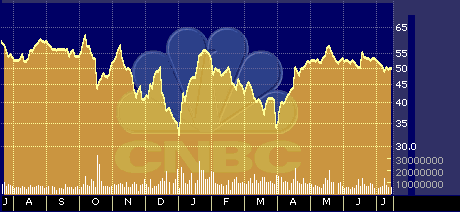
AOL Gives Preview Travel Its Money’s Worth
AOL Gives Preview Travel Its Money’s Worth
by Hal Plotkin
Silicon Valley Correspondent
Preview Travel Inc.’s {PTVL} ads on America Online Inc. {AOL} are generating far-better results, dollar for dollar, than the company’s ad buys on Web portals Excite@Home {ATHM} or Lycos Inc. {LCOS}, according to a recent independent study. While that’s good news for AOL, Lycos and Excite@Home may find it increasingly difficult to attract new advertisers if the finding is replicated in other industries.
The data underscore the growing importance of measuring online-advertising’s impact on sales as opposed to previously used indexes of online popularity, such as the number of unique page views.
“Preview’s deal with AOL has been very rewarding for them,” says the study’s author, Paul Johnson, an analyst at International Data Corp. in Framingham, Mass. “It’s part of the reason AOL can command such high [advertising] rates.”

AOL 52-week stock price chart
San Francisco-based Preview Travel is the exclusive travel provider on AOL, as well as on the Excite@Home and Lycos Web portals. Preview has five-year advertising deals with AOL and Excite@Home at a cost of $32 million and $23.5 million, respectively. Preview is also halfway through a similar two-and-a-half-year $4.5 million ad buy with Lycos.
| Preview Travel’s Advertising Deals | ||
| Company | Contract Length | Cost |
| America Online | Five years | $32 Mln |
| Excite@Home | Five years | $23.5 Mln |
| Lycos | Two-and-a-half years | $4.5 Mln |
Source: IDC
IDC’s numbers reveal the critical difference between generating online traffic and making cash registers ring. AOL is way out in front when it comes to helping Preview Travel turn those visitors into paying customers.
| Preview Travel’s Advertising Financials | ||
| Internet Portal | What it pays (per 1,000 visitors) | What it makes (per dollar spent) |
| America Online | $18.72 | $18.56 |
| Excite@Home | $27.86 | $9.19 |
| Lycos | $6.20 | $8.47 |
Source: IDC
“AOL does a much better job of seamlessly integrating Preview into their travel channel,” Johnson says. “They also add content around Preview’s travel offering and seem to be doing a much better job at that than the portals.”
Although some analysts say it would be a mistake to read too much into Preview Travel’s online-advertising experience, Johnson says the data provide a yardstick that other online advertisers will be looking at in the months and years ahead.
“The first metric will always be traffic, which can help build brand identity,” Johnson says. “But I believe you’ll see more merchants starting to spend time carefully considering what the portal sites can do for them besides building traffic. In the future, a larger percentage of those advertising deals are going to be performance-based.”
Charlene Li, a senior analyst at Forrester Research, based in Boston, agrees. She says just 15 percent of online advertising is performance-based, a number Li says will climb to fully 50 percent by 2003. In performance-based online ad deals, the fees online advertisers pay are based on the actual number of sales generated by the ads.
So what does that mean for Web sites, particularly large portals, that lag behind when it comes to generating returns for advertisers?
“Shakeout,” Li says. “We’re getting to the point where more online advertisers are going to be holding companies accountable. Advertisers will go where they get the best return on their investment.”
But Forrester Research analyst Chris Charron says he thinks it would be a mistake to count out Lycos and Excite@Home based on this one study.
“I don’t think it’s really apples-to-apples,” Charron says. “A variety of factors could be involved. Someone could have a really fantastic deal with Excite@Home, for example, that gives them better results. It really depends on how the ads are positioned on each site and on the details of each particular campaign.”
One advantage AOL enjoys stems from the fact the company has more than 18 million members, says Cameron Meierhoefer, Internet research analyst at PC Data Online, based in Reston, Va. “They know more about the people on their site than the portals do, so it is easier for them to do a better job of targeting users with more appropriate ads or features.”
Li says AOL’s advantage in that respect may diminish over time as online-advertising firms roll out new services that will help portals do a better job of more carefully targeting the ads on their sites.
“The portals are behind, but new technology will help them catch up,” Li says.
In the meantime, Johnson says the data in his study should sound a wake-up call to large Internet portals.
“It gives them an incentive to invest more time and energy with their advertising partners,” Johnson says. “Just putting the ads up is not going to be enough. They’re going to need to develop more-effective strategies for how they can help drive revenue for their advertisers.”
Even the skeptical Charron, agrees. “The previous measures of reach and unique page views are being replaced by metrics that measure efficiency,” he says. “In the end, that’s the only measure that will matter.”


